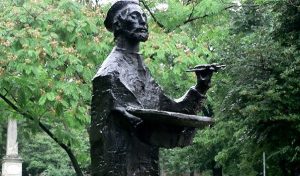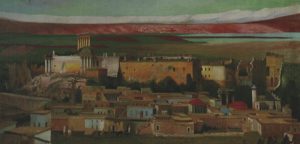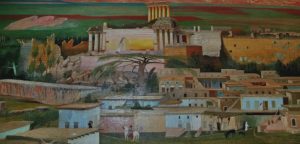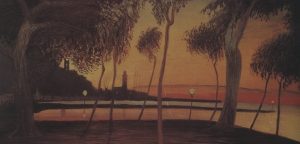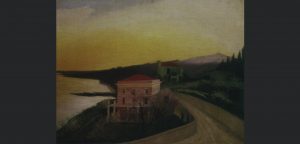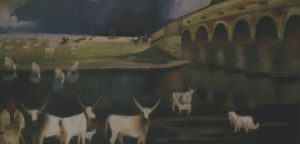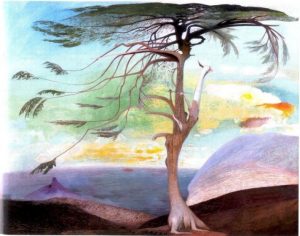The artist was born on the 5th of July in 1853 in Kisszebene, Hungarian Kingdom (now Sabina, Slovakia).
1853 - 1919
Tivadar Csontváry
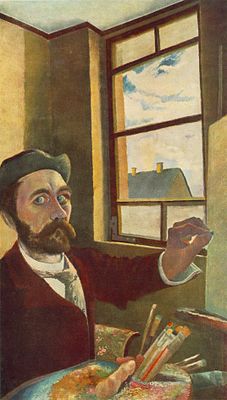
description
A Hungarian self-taught painter of Slovak-Rusyn origin, whose paintings are equally attributed to the styles of primitivism and expressionism.
Tivadar Kostka Csontváry was born into the family of a respected pharmacist. When he was 12 years old, his family moved to Serednye village (now the territory of Zakarpatya, Ukraine). Tivadar was sent to study in the city of Ungvar (now Uzhgorod) at a commercial school (he studied law and pharmacology). After graduation, he worked, like his father, as a pharmacist.
He spent a significant part of his life in Uzhgorod (modern Ukraine). He created paintings and graphic works, depicting what he saw in his multiple travels. He was a patriot of national Hungarian art and relied on the traditions of the people. Paintings by Tivadar Csontváry – mostly plot paintings and portraits – are in demand to this day and are very highly valued at auctions. The largest collection has the Hungarian National Art Gallery (127 paintings) and the Museum of the artist in Pécs. Two monuments to the artist were installed in Uzhgorod, including a mini-sculpture (2016).
Key ideas:
– His whole life and all the work of Tivadar Kostka- Csontváry were subordinated to a single goal – to form their “flow of being” in such a way as to exalt the art of his country.
– The life vocation of the artist can be divided into segments, in which different stages and genres of works are chronologically placed. The first period will include educational drawings, having their own value, and portraits. Then there are paintings of the early 1900s, the most important of which are “Mary’s Well in Nazareth” and other Jerusalem scenes, Baalbek – “the largest solar map of the world”, views of the Tatras. In the last period, there are views of the sea and waterfalls, but the main thing is Lebanese cedars and the metaphorical “Lonely Cedar”.
– The artist traveled a lot, as if he was looking for the truth for his art, his own, as he wrote down, “sunny city”. Thus, an ancient and seemingly deceased city arose on the canvases, although a new one appeared on its ruins along with the embankments of Italy (the “Naples” series), religious places of Jerusalem and Greece.
– The artist declared (he did it frequently and categorically), “I am convinced that the Primordial and Poetic will not leave me, for my soul lives and admires the smallest particles of nature.” Throughout his life, the pharmacist argued that a voice from above that called him to a new path was not accidental and did not lie. The most characteristic of Csontváry colors were turquoise and yellow placed near the necessarily present something dark — be it a mountain or seashore, or a tree trunk. In the choice of colors, there are both reality, and a kind of the understatement of the intent.
– The portraits of the artist do not fit in the framework of the main work (they relate mainly to the early period). In this genre, the artist had always been presented as a naivist. Despite the fact that the talent of the painter, his professional technique and the confidence of his hand are visible, models cause strange feeling. In his subsequent works, Csontváry is a bright, life-affirming master, while there is a feeling of hopelessness and sadness in all portraits without exception.
– He mostly chose images purposefully – those are old and self-contained people. The exception is rather young model Werthmüller, but also with a sad face. When the work was completed, the model exclaimed, “I have been posing for 17 years, but no one has yet managed to draw me like this!” Csontváry no doubt knew how to convey the similarity of the model.
– In the last decade, the artist turned to allegory. The amazingly beautiful and deeply conceived painting “A lonely cedar” is a metaphor of his, Csontváry’s
selfless service to the goal. A tree, just like he himself, does not bother anyone, but does not depend on anyone. The artist explained the idea: this is the way of the Hungarians, who, living in the environment of others, remain on their own, and therefore must develop themselves. He considered himself not just an artist, but also a philosopher, psychologist, politician and even a preacher. He was himself in all guises, remaining lonely, like this cedar on a rock.
1853
1880
1884
1894
1900
1907
1919
The birth of the artist
Went to Italy
In the small village of Igloo, the 28-year-old pharmacist had a dream that led him to the artistic field. He wrote this to an artist (the letter has survived). Next year Kostka went to Italy to see the works of the great Raphael himself, but, in his words, “I did not find real nature”. A little later he met experienced painter Mihai Munkachi in Paris.
He opened his own pharmacy
In order to accumulate funds for the realization of his vocation, he opened his own pharmacy in the town of Gach (north of Hungary) and saved money for ten years; after that, having achieved financial independence, he said goodbye to the pharmacy forever.
Arrived in Munich
Arrived in Munich to start studying painting at the private Academy of Simon Hollosy – a Hungarian artist and talented teacher (the famous colony of artists Nadbanya), a dozen years younger than Csontváry. He also worked with Impressionist painter Friedrich Kallmorgen – Grötzingen colony near Karlsruhe, Germany.
Made long creative journeys
Made long creative journeys around Dalmatia, Bosnia, Italy, Greece, North Africa, the Middle East, as evidenced by travel notes, which the artist constantly led, and even more – the plots of his paintings. The artist began to sign works by the pseudonym “Csontváry”.
He took part in a large international exhibition in the capital of France
He achieved some fame: in 1907, he took part in a large international exhibition in the capital of France; the following year, he exhibited his works at the Art Gallery in Budapest. During those years, the most significant canvases were created: “The Well of Mary”, “The Lonely Cedar” and others. Csontváry’s paintings were approved, in particular, by an eminent American art historian; however, this did not influence the destiny of the self-taught artist.
The death
Tivadar Csontvary died on the 20th of June in 1919 in Budapest, Hungary.

